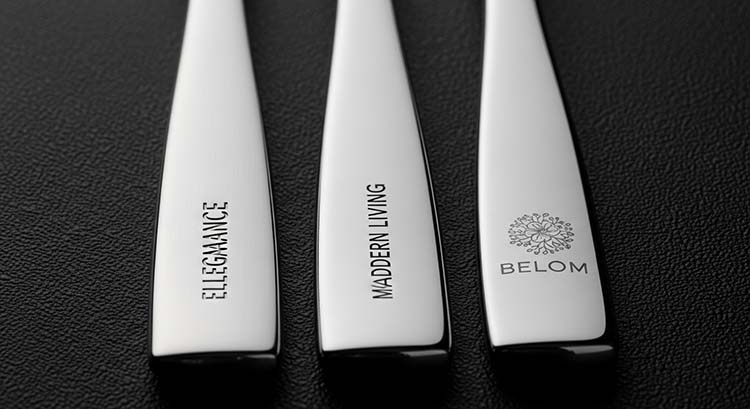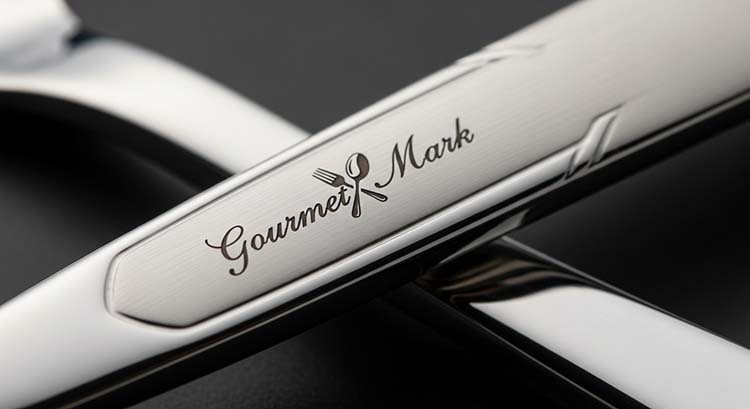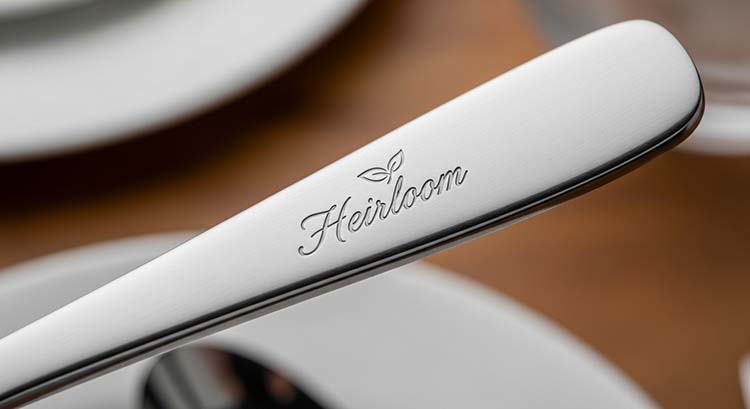Laser Engraving vs. Etching vs. Stamping: Which is best for your cutlery logo?
Choosing the wrong logo method ruins your cutlery's premium look. It can fade, look cheap, or cost too much, damaging your brand's image with every use.
The best method depends on your needs. Choose laser engraving for precision and durability, etching for cost-effective simple logos, and stamping for a permanent, tactile impression on large orders. Each offers a different balance of cost, detail, and aesthetic.

I remember walking through the factory with Jacky, a seasoned buyer for a major US brand. He was launching a new line for a hotel client and had a very intricate logo. He pointed to an engraving machine and then to a stamping press. "Linc," he said, "don't just tell me the price difference. Tell me which one will still look perfect after 1,000 trips through a commercial dishwasher. My client's brand is on that handle." He was right to focus on the long-term result. The customization method you choose is just as important as the cutlery itself. Let's look at the options.
Is Laser Engraving the Most Durable Choice for a Premium Logo?
You need a complex logo on your cutlery that won't wear off. Cheaper methods fade in the dishwasher, making your premium product look second-rate and disappointing customers.
Yes, laser engraving is the most durable choice for detailed designs. It physically removes a micro-layer of steel to create a permanent, high-resolution mark. It's the modern standard for premium cutlery where logo precision and longevity are essential.

Laser engraving is a fascinating process to watch. There are no chemicals or inks involved. A high-powered, computer-guided laser beam focuses on the surface of the stainless steel. It vaporizes a tiny layer of the metal, creating a clean, crisp, and permanent mark. Because it literally carves the design into the steel, the logo cannot fade, peel, or wash away. This makes it perfect for intricate or delicate logos that would be impossible to create with other methods. It gives a sharp, professional finish that communicates quality and attention to detail. The cost per piece is slightly higher than etching, but there isn't a large mold fee like with stamping. This makes it flexible for both small, exclusive runs and large-scale orders of high-end cutlery. It's the go-to choice for brands that want the best in precision and permanence.
When Is Chemical Etching the Smartest, Most Cost-Effective Option?
You need to brand your cutlery but are working with a tight budget. Laser engraving seems too expensive for your project, but you need something more professional than a simple print.
Etching is the most cost-effective solution for simple logos on mid-range or promotional cutlery. It creates a permanent, subtle matte finish that is more durable than ink. While less detailed than engraving, it delivers excellent value for high-volume orders.

Chemical etching1 is a classic method that's great for certain projects. First, we create a stencil, or "resist," of your logo and apply it to the cutlery. The piece is then exposed to a specific chemical solution. This solution eats away at the unprotected steel, creating a shallow, permanent mark. The resulting logo usually has a subtle, frosted, or matte gray appearance, which is different from the crisp black or dark gray of a laser engraving. It's not the best choice for very fine details. However, for simple text or bold logos, it is very effective. The main advantage is cost. For large production runs, etching is significantly cheaper per unit than laser engraving. It's an excellent choice for promotional items, airline cutlery, or mid-range restaurant sets where you need a permanent logo without the premium cost of more advanced methods.
| Feature | Laser Engraving | Chemical Etching |
|---|---|---|
| Durability | Excellent | Good |
| Level of Detail | Very High | Low to Medium |
| Cost Per Unit | Medium | Low |
| Best For | Complex logos, premium brands | Simple logos, large volume orders |
Should You Choose Stamping for the Most Classic, Permanent Logo?
You want a timeless logo with a tactile feel that will never fade away. Engraved and etched logos are flat and just don't have that traditional, indented quality you're looking for.
Yes, stamping is the best method for a classic, permanent logo intended for very large production runs. It uses a high-pressure press to indent the logo into the steel itself. This creates a premium, tactile look that is physically part of the utensil.

Stamping, or die-casting, is the most traditional way to brand cutlery. It's a purely mechanical process. First, we have to create a custom, hardened steel die with your logo on it. This die acts as a mold. Then, we use a powerful press to strike the cutlery with the die, permanently imprinting the design into the steel. The logo is not on the surface; it is part of the surface. You can feel the depth with your finger. This is the ultimate in durability—it will last as long as the spoon or fork itself. However, there are two main considerations. First, the upfront cost to create the custom die is significant, making it unsuitable for small orders. Second, it works best for simple, bold logos. Very fine details can be lost. It's the perfect choice for heritage brands or large-scale orders that want to convey a sense of permanence and classic quality.
Conclusion
Your choice depends on budget, logo complexity, and brand identity. Match the method to your product tier and order volume to ensure the perfect, lasting impression for your brand.
-
Explore this link to understand the process and benefits of chemical etching in various applications. ↩
